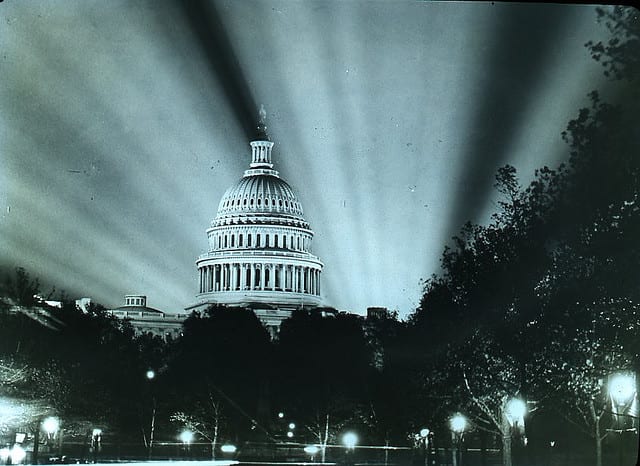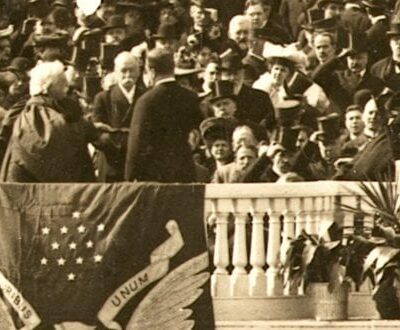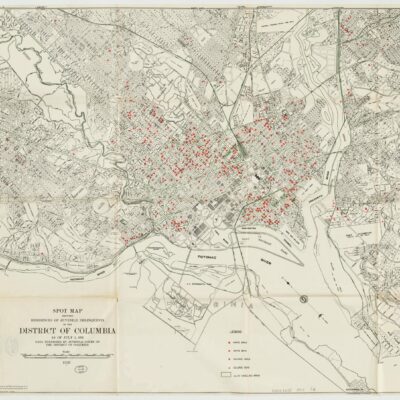Here’s an excellent photo from the DC Public Library Flickr photostream. This shows the Capitol Building fully lit up following announcement of the end of World War I.
The end of the Great War has lost its luster in place of the end of the Second World War … but it was an equally, if not more celebratory occasion, given that it was the war to end all wars.
Here’s the report from the Baltimore Sun on November 8th, 1918.
Washington, Nov. 7.–Delirious with delight over a cabled report from Europe that germany had signed the Allied armistice terms and hostilities had ceased at 2 o’clock this afternoon, Washington wildly celebrated the announcement until midnight, despite the fact that the War and State Departments absolutely refused to confirm the statement. By the time darkness fell, 200,000 persons blowing horns, waving flags, singing “My Country, Tis of Three” and racing through the streets in automobiles and motortrucks, had turned the city into a bedlam. Never have such scenes of wild and delirious joy gripped the people of the national capital.
The first report of armistice having been signed came shortly after noon, when a local paper put out an extra. This was not convincing. Shortly afterward the St. Angelus siren on the Evans Building, where the SUN Bureau is located, began to toot. It had been announced that this siren would not blow until the official news of the signing of the armistice had been made. Then Washington went crazy with joy.
Tens of thousands of war workers dropped their work over the protest of their chiefs and leaped through the doorways into the streets. They began marching, yelling like mad, singing and waving flags. It was not long before every Government department practically ceased work. More than 100,000 persons jammed the streets, and the wildest celebration Washington has ever seen began.
Appeals from the State Department that the celebration be withheld until official confirmation had been received had no affect on the crowd. Washington believed the armistice had been signed and wanted to celebrate, and it did.
A marching crowd of several thousand men, women and children, led by a sailor, a soldier and a marine, each carrying an American flag, appeared in front of the White house. Led by the sailor, the crowd began singing “My Country Tis of Three.” Between 4,000 and 5,000 persons watching the demonstration uncovered their heads and joined in the anthem. Yells were made for President Wilson, and he appeared on the White House portico and waved his hand at the crowd. Then a mighty shout shook the heavens. The crowd accepted the President’s appearance as official confirmation of the signing of the armistice, and the enthusiasm knew no bounds.
In the meantime a hastily-cabled inquiry by Secretary of State Lansing concerning the report brought an answer that the report was untrue. The crowd did not know it and would not have believed it had they been told, so intoxicated with joy were they.

Most of us have never experienced anything like this — frankly, hopefully we never will — but I’m sure you can imagine the unbelievable collective emotional relief and celebration that resulted.
Take a look at the video above. It shows Wilson leaving the White House to the Capitol Building and the unbelievably large crowds gathered in the streets.
After the President had appeared before the crowd there was no possibility of restoring the equilibrium of Washington. War workers had organized parades by the score. Heavy army trucks were rumbling up and down Pennsylvania avenue, loaded with thousands of school children, each waving a flag and yelling to the limits of their lung power. The war workers who did not leave their building crowded to the windows waiving flags and sang. Others gave three cheers for Pershing.
Crippled soldiers from Walter Reed Hospital, invalid from the battle fields of France, rode down the avenue in automobiles and waved their crutches at the thousands of cheering spectators on the sidewalks. Soldiers, sailors and civilians, arm in arm, paraded, beat drums, blew horns, beat tin pans or made some other kind of noise.
Meanwhile, a half dozen army aviators in biplanes and naval aviators in hydroplanes flew over the crowds, some of them diving to almost the house tops along Pennsylvania avenue and giving the throngs in the street one thrill after another.
All these activities were construed by the populace as confirmation of the hoped-for news. An enormous crowd of employes of the Treasury Department sent a delegation to the Secretary of War Baker to request him to make a speech. He sent back word that the Government had received no confirmation of the report, and that it obviously was untrue. This did not dampen the spirits of the crowd perceptibly.
Wow. I can only think of two other occasions that were close to this level of celebration. The first being the Civil War and the second of course, World War II.





















